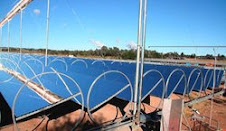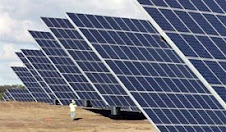Solar Energy Helps Fuel Socially Responsible Investing
by William Baue
Managers from Winslow Green Growth Fund, New Alternatives Fund, and Portfolio 21 discuss the opportunities and challenges of investing in solar power.
SocialFunds.com -- All energy on earth originates from our sun (with the exception of nuclear, which is galactic in origin)--including oil, which is solar energy stored in fossilized carbon deposits. With the days of oil prices below $50 a barrel behind us and climate change marching forward, investment in less polluting, renewable energy sources is on the rise.
Solar energy, which transforms energy from the sun more directly into usable forms, is playing an increasingly important role in our evolving energy mix. While some investors are just jumping onto the solar bandwagon, many socially responsible investing (SRI) firms have a longer history of exposure to this growing sector.
"Interest in solar power and solar stocks has never been higher," says Matt Patsky, a portfolio manager of the Winslow Green Growth Fund (ticker: WGGFX) at Winslow Management Company, which has practiced "green" (or environmentally effective) investing since 1984. "The number of small, public solar companies has been increasing, with several recent solar IPOs."
These initial public offerings have been quite successful, according to David Schoenwald, portfolio manager of the New Alternatives Fund (NALFX) that launched in 1982 as the first environmental fund. For example, IPOs for China-based SunTech Power (STP--whose offering launched just this week) and US-based SunPower (SPWR--which spun off Cypress Semiconductor (CY) in the past few weeks) were both oversubscribed. Other recent IPOs include Germany-based Conergy (CGY.DE) and Q-Cells (QCE.DE). Other "pure plays," or small companies focused exclusively on solar, include US-based Evergreen Solar (ESLR) and DayStar Tech (DSTI), and Germany-based ErSol Solar (ES6.DE).
"Only a few of these pure plays are profitable yet, which is a challenge for Wall Street," says Carsten Henningsen, chair of Portfolio 21 (PORTX), a global sustainability fund launched in 1999. "For example, SunTech Power has been profitable since 2003, but as a Chinese company it has direct access to cheap labor and production and may engage in questionable accounting."
"Q-Cells and ErSol are also recently profitable," Mr. Henningsen told SocialFunds.com. "Although companies present themselves as profitable, it would be wise to examine cash flows and future prospects before investing."
These mutual funds have been profitable, too. Three-year annualized returns as of November 30, 2005 are 28.52 percent for Winslow, 13.46 for Portfolio 21, and 13.26 for New Alternatives, according to data provided by Thomson Financial Network.
While Winslow is limited to pure plays as a small-cap fund, New Alternatives and Portfolio 21 gain more exposure to solar through large, diversified companies with commitments to solar.
"The larger companies like Sharp have the advantage when it comes to economies of scale, relationships with suppliers, research and development budgets, and cash to grow market share," says Mr. Henningsen. "We like Sharp because the company is the largest Japanese solar battery producer and passes Portfolio 21's strict sustainability criteria."
The solar market may also be fueled by recent commitments to support renewable energy from large conglomerates such as GE (GE), BP (BP), and even Wal-Mart (WMT).
"We believe that these announcements amount to validation of what alternative energy proponents have been saying--that alternative energy sources will be needed to meet the world's energy demands, and renewables such as solar will have major roles to play," said Liz Levy, Winslow's environmental analyst. "Solar companies can currently sell all of the product they make--crunch time will come in the future as silicon supplies ease and investments from large organizations such as these begin to materialize."
Silicon is the primary raw material behind solar technology (with few exceptions, such of DayStar's non-silicon technology), so fluctuations in quality and supply of silicon pose a significant challenge to this relatively young industry.
"New developments in raw materials and technology are yielding different types of solar cell construction with different efficiencies and different quality materials--for example, we are seeing more product options like thinner film solar cells that use lower quality silicon," points out Mr. Henningsen. "The lower quality cells are less expensive, however the efficiencies are very low."
"However, in some applications such as in developing countries with far less power demands than the US, these lower cost and lower quality cells may work well," he adds.
Subsidy schemes in various parts of the world are also fueling opportunity in the solar sector.
"The markets with the greatest support are in Germany and Spain--there is also strong support in a number of states in the US," Mr. Schoenwald of New Alternatives told SocialFunds.com.
Just this week, the California Public Utilities (CPUC) unveiled the California Solar Incentive Program that offers $3.2 billion in incentives over the next decade to build solar panels on homes and businesses.
Other significant opportunities of the future have yet to hit publicly-traded markets.
"While the greatest investor interest is presently solar photovoltaic cells that produce electricity, I personally think solar hot water heating systems may be more cost effective," adds Mr. Schoenwald. "There are a number of private solar hot water heating system companies, especially in China, but no public ones that I'm aware of."
Article from SocialFunds.com
Best Green Stocks Investing Blog
Saturday, December 24, 2005
Subscribe to:
Post Comments (Atom)
Yuya Joe Blog
Lake Ontario Waterkeeper
The Daily Beast -Politics Blog
21stArch.com - 21st Century Architecture
Original Joe College Blog
WikiLeaks Foreign Policy Analysis
AGreenRealtor.com Real Estate Blog - Ecology Energy Efficiency
Best Green Stocks Investing Blog
PV Intell Photovoltaic Solar Stocks Investing
SEARCH Leading Alternative Energy and Ethical Investing websites

Custom Search
Daily Kos
Rare Earth Stocks Research
Patrick MacManus's Blog Peace and Collaborative Development
BeesTreesFrogsElephants.com - Nature and Ecology Blog
Research Green Energy stocks, Clean Energy investing information
Find wind power investing info online, clean energy mutual funds, geothermal stocks, solar energy investments.

Green Energy Investing Network:
Green Stocks Investing Clean Power Blog
SolarIntell.com Renewable Power Investing Website
Wind Intell.com Wind Energy Stocks Company Links
Geothermal Power Investing Public Companies
PV Intell.com Leading Photovoltaic Solar Energy Stocks

Custom Search
Green Energy Investing Network:
Green Stocks Investing Clean Power Blog
SolarIntell.com Renewable Power Investing Website
Wind Intell.com Wind Energy Stocks Company Links
Geothermal Power Investing Public Companies
PV Intell.com Leading Photovoltaic Solar Energy Stocks







No comments:
Post a Comment